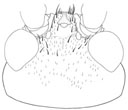|
Song at 25°C:
|
Tinkling melodious trills lasting 0.5–2 sec. Pulses within trill are not paired and have two modes of spacing that correspond to 11 and 14 p/s.
|
|
Identification:
|
Length 15-19 mm. Ocellar diameter less than distance between lateral and median ocellus; no conical projections at ocelli; some bristles longer than 0.1 mm on head behind lateral ocelli. Face usually dark medially but if there is a median light area it is shaped like an inverted V, and the median portion of the face just above the light band along the epistomal suture is dark. Stridulatory file has 125–145 teeth.
|
|
Similar species:
|
(l) Black-faced bush cricket (O. nigrifrons)—no bristles longer than 0.1 mm on head behind lateral ocelli; stridulatory file has 98–110 teeth. (2) Three-horned bush cricket (O. tricornis)—conical projections at ocelli; stridulatory file has 110-130 teeth.
|
|
Habitat:
|
Black and white mangroves.
|
|
Season:
|
Year round.
|
|
More information:
|
Subfamily Eneopterinae, genus Orocharis.
|
|
Nomenclature:
|
OSF (Orthoptera Species File Online).
|










